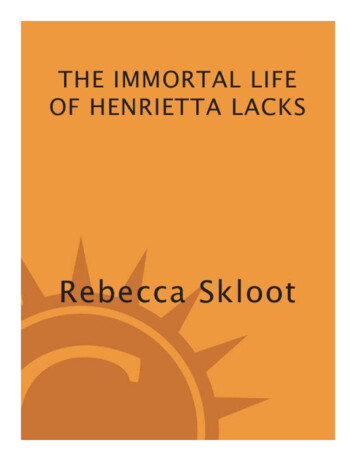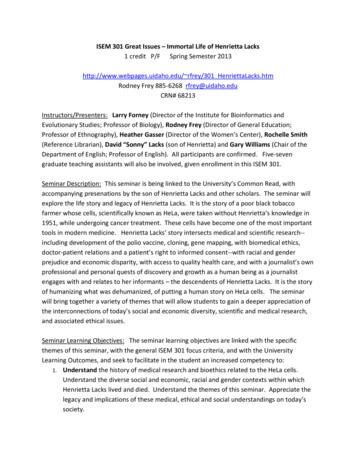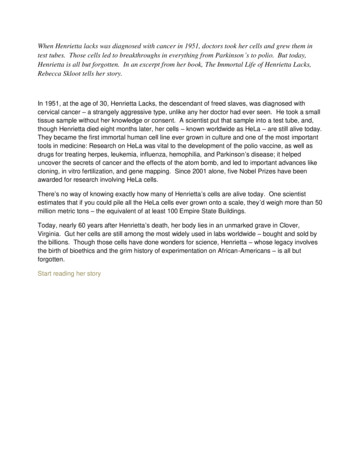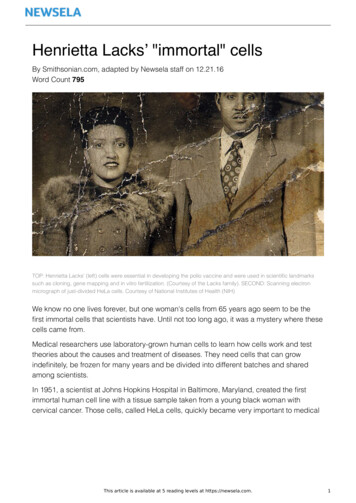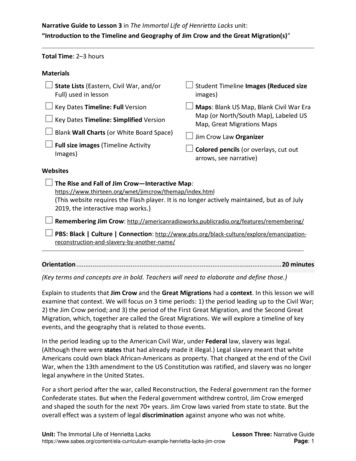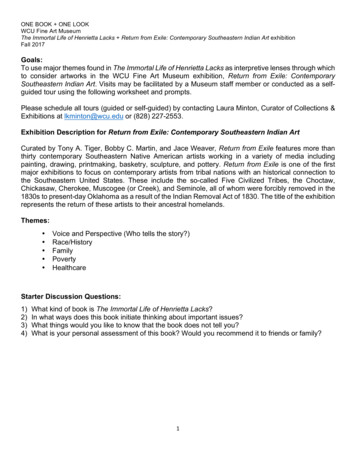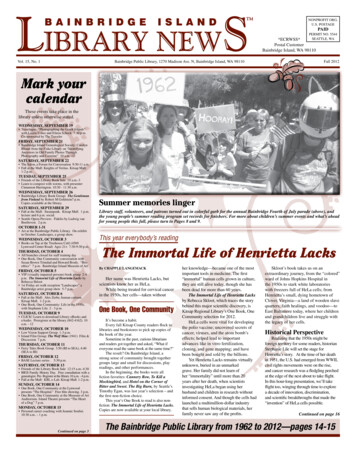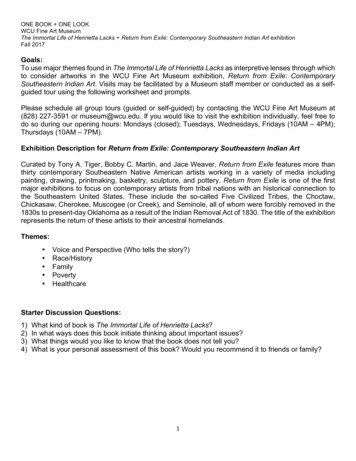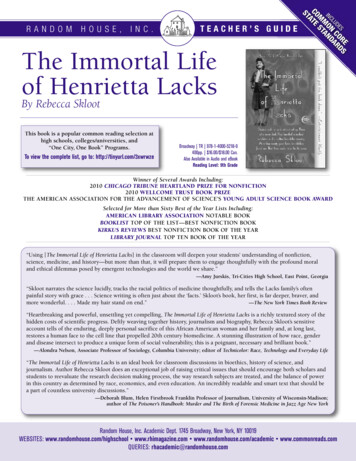
Transcription
HOUSE, INC.TEACHER’S GUIDEThe Immortal Lifeof Henrietta LacksE SES OR DUD C ARCLIN ON NDM AM STCO TEASTRANDOMBy Rebecca SklootThis book is a popular common reading selection athigh schools, colleges/universities, and“One City, One Book” Programs.To view the complete list, go to: http://tinyurl.com/3xwrwzeBroadway TR 978-1-4000-5218-9400pp. 16.00/ 18.00 Can.Also Available in Audio and eBookReading Level: 9th GradeWinner of Several Awards Including:2010 CHICAGO TRIBUNE HEARTLAND PRIZE FOR NONFICTION2010 WELLCOME TRUST BOOK PRIZETHE AMERICAN ASSOCIATION FOR THE ADVANCEMENT OF SCIENCE’S YOUNG ADULT SCIENCE BOOK AWARDSelected for More than Sixty Best of the Year Lists Including:AMERICAN LIBRARY ASSOCIATION NOTABLE BOOKBOOKLIST TOP OF THE LIST—BEST NONFICTION BOOKKIRKUS REVIEWS BEST NONFICTION BOOK OF THE YEARLIBRARY JOURNAL TOP TEN BOOK OF THE YEAR“Using [The Immortal Life of Henrietta Lacks] in the classroom will deepen your students’ understanding of nonfiction,science, medicine, and history—but more than that, it will prepare them to engage thoughtfully with the profound moraland ethical dilemmas posed by emergent technologies and the world we share.”—Amy Jurskis, Tri-Cities High School, East Point, Georgia“Skloot narrates the science lucidly, tracks the racial politics of medicine thoughtfully, and tells the Lacks family’s oftenpainful story with grace . . . Science writing is often just about the ‘facts.’ Skloot’s book, her first, is far deeper, braver, andmore wonderful. . . . Made my hair stand on end.”—The New York Times Book Review“Heartbreaking and powerful, unsettling yet compelling, The Immortal Life of Henrietta Lacks is a richly textured story of thehidden costs of scientific progress. Deftly weaving together history, journalism and biography, Rebecca Skloot’s sensitiveaccount tells of the enduring, deeply personal sacrifice of this African American woman and her family and, at long last,restores a human face to the cell line that propelled 20th century biomedicine. A stunning illustration of how race, genderand disease intersect to produce a unique form of social vulnerability, this is a poignant, necessary and brilliant book.”—Alondra Nelson, Associate Professor of Sociology, Columbia University; editor of Technicolor: Race, Technology and Everyday Life“The Immortal Life of Henrietta Lacks is an ideal book for classroom discussions in bioethics, history of science, andjournalism. Author Rebecca Skloot does an exceptional job of raising critical issues that should encourage both scholars andstudents to reevaluate the research decision making process, the way research subjects are treated, and the balance of powerin this country as determined by race, economics, and even education. An incredibly readable and smart text that should bea part of countless university discussions.”—Deborah Blum, Helen Firstbrook Franklin Professor of Journalism, University of Wisconsin-Madison;author of The Poisoner’s Handbook: Murder and The Birth of Forensic Medicine in Jazz Age New YorkRandom House, Inc. Academic Dept. 1745 Broadway, New York, NY 10019WEBSITES: www.randomhouse.com/highschool www.rhimagazine.com www.randomhouse.com/academic www.commonreads.comQUERIES: rhacademic@randomhouse.com
about the bookIn 1950, Henrietta Lacks, a young mother of five children, entered the colored ward of TheJohns Hopkins Hospital to begin treatment for an extremely aggressive strain of cervicalcancer. As she lay on the operating table, a sample of her cancerous cervical tissue was takenwithout her knowledge or consent and given to Dr. George Gey, the head of tissue research.Gey was conducting experiments in an attempt to create an immortal line of human cellsthat could be used in medical research. Those cells, he hoped, would allow scientists tounlock the mysteries of cancer, and eventually lead to a cure for the disease. Until this point,all of Gey’s attempts to grow a human cell line had ended in failure, but Henrietta’s cellswere different: they never died.Less than a year after her initial diagnosis, Henrietta succumbed to the ravages of cancer andwas buried in an unmarked grave on her family’s land. She was just thirty-one years old. Herfamily had no idea that part of her was still alive, growing vigorously in laboratories—first atJohns Hopkins, and eventually all over the world.Thirty-seven years after Henrietta’s death, sixteen-year-old Rebecca Skloot was a high schoolstudent sitting in a biology class when her instructor mentioned that HeLa, the firstimmortal human cell line ever grown in culture, had been taken from an African Americanwoman named Henrietta Lacks. His casual remark sparked Skloot’s interest, and led to aresearch project that would take over a decade to complete. Her investigation of the truestory behind HeLa eventually led her to form significant––and in some cases, lifechanging––relationships with the surviving members of the Lacks family, especiallyHenrietta’s daughter, Deborah.In telling Henrietta’s story, Skloot draws from primary sources and personal interviews toprovide insightful narrative accounts of Henrietta’s childhood, young adulthood, diagnosis,illness, and tragic death. She also explores the birth and life of the immortal cell line HeLa,and shows how research involving HeLa has changed the landscape of medical research,leading to not only scientific and medical breakthroughs, but also new and evolving policiesconcerning the rights of patients and research subjects.As the story of HeLa unfolds, so does the story of Henrietta’s surviving children, who fortwo decades were unaware of the existence of their mother’s cells—and the multimilliondollar industry that developed around the production and use of HeLa. Central to thisnarrative is the relationship between Skloot and Deborah. As Skloot tenaciously worked togain Deborah’s trust, Deborah struggled to understand what had happened to her motherand her mother’s cells. The result of their relationship is an illuminating portrait of theenduring legacy of Henrietta’s life, death, and immortality.about the authorREBECCA SKLOOT is an award-winning science writer whose articles have appeared inThe New York Times Magazine; O, The Oprah Magazine; Discover; Prevention; Glamour; andothers. She has worked as a correspondent for NPR’s Radiolab and PBS’s NOVA scienceNOW,and is a contributing editor at Popular Science magazine and guest editor of The Best AmericanScience Writing 2011. Her work has been anthologized in several collections, including TheBest Creative Nonfiction. She is a former vice president of the National Book Critics Circle,and has taught creative nonfiction and science journalism at the University of Memphis, theUniversity of Pittsburgh, and New York University. She lives in Chicago. The Immortal Life ofHenrietta Lacks is her first book. It is being translated into more than twenty languages andadapted into an HBO film produced by Oprah Winfrey and Alan Ball. She is the Founderand President of the Henrietta Lacks Foundation. For more information, visit her website atRebeccaSkloot.com, where you’ll find links to follow her on Twitter and Facebook.random house, inc. teacher’s guide2
about the guideThe Immortal Life of Henrietta Lacks contains three main narratives, each with uniqueapplications to the disciplines of language arts, history, and science. As a result, this guide isstructured to provide discussion and writing activities that will engage students inresearching, reading, and writing across the curriculum.Guided Reading and Discussion Questions are provided for each chapter. These questionsencourage students to engage in a close reading of the text, prompting them to clarify orinfer meaning and to pause to examine not only what is written, but how it is written.Writing Prompts are thematic and organized in sections that may be of special interest to thedisciplines of language arts, social studies, and science. These prompts guide studentstoward an in-depth analysis of the themes and issues central to the story of Henrietta Lacks,and several may promote outside reading or research. Teachers are encouraged to adaptsome of the prompts for use in debates or Socratic seminars. The questions in the finalsection, Topics for Further Discussion, require students to expand their thinking and engage insignificant research activities related to subjects or issues raised in the book. Many of thesetopics could be easily applied to group projects.There are many excellent multimedia resources related to this book available on the author’swebsite at RebeccaSkloot.com. Links to several radio productions and podcasts are providedat the end of the guide. Teachers are strongly encouraged to share the Radiolab episode withtheir students, as it includes audio recordings that the author taped while researching thebook, and illuminates several key scenes from the book.before you readPoint out the differences between the genres of historical fiction and nonfiction. Define“creative nonfiction,” a genre in which all facts are accurate and verifiable, but presented in acreative way that emphasizes storytelling through the use of scenes, dialogue, and othertechniques more often found in fiction. Discuss the differences between creative nonfictionand traditional journalism. Discuss the methods by which a nonfiction writer is able torecreate dialogue and recount descriptions of historical events and locations. Direct studentsto carefully examine the endnotes and foreword of the book, and discuss the specific stepsand sources that the author used to ensure that the narrative account of Henrietta’s life isfactual and accurate.As a writing assignment, have students practice writing completely factual and objectivenarrative descriptions of historical locations or figures based on primary source documentssuch as photographs, eyewitness accounts, testimonies, and public records.www.randomhouse.com/highschool3
guided reading and discussion questionsPrologue: The Woman in the Photograph1. The author uses several similes to describe cells. What simile does she use to describethe way a cell looks? What simile does she use to explain the functions of the differentparts of a cell? What do these similes suggest about biology?2. What is mitosis? What beneficial biological processes involve mitosis?3. What simile does Donald Defler use to describe mitosis?4. What happens when there is a mistake during the process of mitosis?5. According to Defler, how important was the discovery of HeLa cells?6. As a high school student, Skloot began researching HeLa cells to find out more aboutHenrietta Lacks. Examine pages 5 and 6 and write down each step that Skloot took tobegin her research.Chapter One: The Exam1. How long did Henrietta wait between first telling her girlfriends that “something didn’tfeel right” and going to the doctor?2. Why does Sadie think Henrietta hesitated before seeing a doctor?3. What did Henrietta’s first doctor assume the source of the lump on Henrietta’s cervixwas? What stereotype or bias might this assumption be based upon?4. Why did David Lacks take Henrietta to the public wards at Johns Hopkins instead of acloser hospital?5. Explain what the Jim Crow laws were.6. Who was Henrietta’s gynecologist?7. Review the notes on Henrietta’s medical history found on page 16. Based on theobjective details in her medical chart, what can you infer about Henrietta’s life andpersonality?8. Based on her medical chart, how would you describe Henrietta’s feelings aboutdoctors?9. What did Howard Jones find “interesting” about Henrietta’s medical history? What doesthis finding suggest about Henrietta’s cancer?Chapter Two: Clover1. Why did Henrietta end up being raised by her grandfather, Tommy Lacks?2. What are the connotations of the term “home-house”? What does this term suggestabout the values of the Lacks family?3. How was Day related to Henrietta?4. Skloot uses vivid imagery and details to describe Henrietta’s childhood in Clover.Locate a passage that you found particularly effective or memorable, and explain whyyou selected it.5. Describe the relationship between Crazy Joe and Henrietta.6. How old was Henrietta when she had her first child with Day?7. What was different about Henrietta’s second child, Elsie?random house, inc. teacher’s guide4
guided reading and discussion questions (continued)8. Compare the medical terms describing Elsie’s condition with the terms used byHenrietta’s friends and family. What are the connotations of the two sets of terms?9. How did Pearl Harbor change life in Turner Station?10. Contrast the working conditions of black workers and white workers at the SparrowsPoint Steel Mill.Chapter Three: Diagnosis and Treatment1. How are different types of cancer categorized?2. Summarize Dr. TeLinde’s position in the debate over the treatment of cervical cancer.3. Explain how the development of the Pap smear improved the survival rate of womendiagnosed with cervical cancer.4. How did doctors justify using patients in public hospital wards as medical researchsubjects without obtaining their consent or offering them financial compensation? Doyou agree or disagree with their reasoning? Explain your answer.5. How did TeLinde hope to prove that his hypothesis about cervical cancer was correct?6. What was George Gey’s position at Johns Hopkins?7. Explain what an immortal cell line is.8. Explain how TeLinde and Gey’s relationship led to Gey obtaining a tissue sample fromHenrietta’s tumor.9. Analyze the consent statement that Henrietta signed on page 31. Based on thisstatement, do you believe TeLinde and Guy had the right to obtain a sample from hercervix to use in their research?10. Do you think Henrietta would have given explicit consent to have a tissue sample usedin medical research if she had been asked? Do you think she would have understoodwhat was being asked of her? Explain your answers.11. Were cells taken only from black patients? Were black patients generally treateddifferently from white patients in the early 1950s? Explain your answers.Chapter Four: The Birth of HeLa1. Summarize the main obstacles Gey and his assistants faced in their effort to grow cells.2. Where did the name “HeLa” come from?3. Based on the descriptions of Gey found on pages 38–39, offer three adjectives that bestdescribe his personality.4. Explain how Gey’s roller-tube culturing technique works.5. What happened to the HeLa cells that Mary cultured?6. Gey chose to give away samples of HeLa to his colleagues almost immediately. Do youthink this was a good decision? Explain your answer.7. Once HeLa started growing, was Henrietta informed that her cells were being used inGey’s research?8. What is the implication of the author’s decision to use the term “birth” to describe theinitial growth of HeLa cells?www.randomhouse.com/highschool5
guided reading and discussion questions (continued)Chapter Five: “Blackness Be Spreadin All Inside”1. After her diagnosis and treatment, how did Henrietta behave? What can you inferabout her personality based on this behavior?2. According to Ethel’s cousins, why did she dislike Henrietta?3. What was Elsie’s early life like?4. Why did Henrietta and David (Day) Lacks decide to place Elsie in the Hospital for theNegro Insane?5. What specific details let the reader know that sending Elsie away was difficult forHenrietta?6. Why do you think Henrietta initially chose not to tell people about her cancerdiagnosis? What does this decision suggest about Henrietta’s personality?7. What important information did Henrietta’s doctor fail to give her before starting hercancer treatment? How did she react when this information was eventually shared withher?Chapter Six: “Lady’s On the Phone”1. Explain who Roland Pattillo is. How is he connected to both Henrietta Lacks andGeorge Gey?2. Paraphrase the information on page 50 describing the Tuskegee Syphilis Study.3. What do the Tuskegee Syphilis Study and the Mississippi Appendectomies suggestabout the history of African Americans and medicine?4. Why do you think Pattillo agreed to help Skloot contact Henrietta’s family?5. What does Pattillo tell Skloot about Elsie Lacks?6. How does Deborah Lacks initially respond to Skloot’s request for information?7. What questions does Deborah have about her mother?8. How does Day initially respond to Skloot’s request for information?Chapter Seven: The Death and Life of Cell Culture1. What did Gey hope to accomplish with HeLa cells?2. What did HeLa allow scientists to do for the first time?3. Who was Alexis Carrel? Why did he win the Nobel Prize?4. How did the media react to Carrel’s announcement that he had grown immortalchicken heart cells?5. What controversial beliefs did Carrell have?6. Give an example of propaganda that was used to fuel the public’s fear and distrust oftissue culture.7. What details suggest that Carrel’s claims about the immortal cell line were notscientifically sound?random house, inc. teacher’s guide6
guided reading and discussion questions (continued)Chapter Eight: “A Miserable Specimen”1. After her initial round of treatment, what did Henrietta’s doctors assume about theeffectiveness of the radium therapy?2. How did her doctors react to Henrietta’s intuitive conviction that the cancer wasspreading inside of her?3. In your own words, explain the paradox “benevolent deception.”4. When did the doctors realize that Henrietta had been correct about the growth of hercancer?5. What objective details suggest that Henrietta was in extreme pain at this point in herillness?6. What objective details suggest that Henrietta was a devoted and loving mother?7. What does the use of the term “a miserable specimen” by Henrietta’s doctors revealabout their attitude toward her?8. While most accounts suggest that Henrietta never met George Gey or knew aboutHeLa, Laure Aurelian says that Gey recounted meeting with Henrietta before her death.Do you find this story believable? Use specific facts about Henrietta, Gey, and/ormedical practice in the 1950s to support your opinion.9. If Gey did speak to Henrietta just before she died, do you think she would haveunderstood what immortal cells were? Explain your answer.Chapter Nine: Turner Station1. How does Skloot proceed with her research when it becomes clear that Sonny Lacks isnot going to meet with her?2. Compare and contrast the Turner Station that Skloot visited in 1999 with the TurnerStation that Henrietta experienced as a young woman.3. What does the fact that the town still has “more than ten churches” suggest about thepeople in Turner Station?4. Who is Courtney “Mama” Speed, and how is she connected to Henrietta Lacks?5. What subjective conclusions can you make about Mama Speed based on the objectivedetails on page 72?6. Make a prediction based on the foreshadowing regarding Mr. Cofield. What do youthink Cofield did?7. What does Skloot realize after watching the BBC documentary about HeLa?Chapter Ten: The Other Side of the Tracks1. Explain the meaning of the idiom “the other side of the tracks.”2. What do the names of the creek and the river suggest about life in Lacks Town?3. How was Cootie related to Henrietta?4. What illness did Cootie have as a child?www.randomhouse.com/highschool7
guided reading and discussion questions (continued)5. Cootie seems to know and understand a little bit about HeLa cells, but he believes thatHenrietta’s spirit is still present in her cells. What does Cootie think about the reasonthat HeLa cells were used to develop a polio vaccine?6. Where does Cootie think Henrietta’s cancer came from?Chapter Eleven: “The Devil of Pain Itself”1. Describe the progression of Henrietta’s cancer in the eight months between herdiagnosis and her death.2. Why did doctors stop giving Henrietta blood transfusions?3. What did Henrietta’s friends and family do when they found out that she neededblood? Why do you think they were willing to sacrifice to help her?4. What was Henrietta’s final request? What does this request tell you about her?Chapter Twelve: The Storm1. Why did Henrietta’s doctors need to ask for her family’s permission to remove tissuesamples after her death? How did Day initially respond to their request?2. What made Day change his mind and allow the autopsy?3. What did Mary, Gey’s assistant, realize when she saw Henrietta’s painted toenails? Howwas the timing of this realization ironic?4. What happened when the family started to bury Henrietta’s body?5. Henrietta’s cousin says that Henrietta “was tryin’ to tell us somethin’ with that storm.”What do you think she could have been trying to say?Chapter Thirteen: The HeLa Factory1. Explain how a neutralization test is used to determine a vaccine’s efficacy.2. What unusual characteristics of HeLa cells made them ideal for use in the polio vaccinetrials?3. Why did the Tuskegee Institute become involved in the mass production of HeLa cells?Describe the depth of the Institute’s involvement.4. Explain the inherent irony of the fact that the Tuskegee HeLa production lab wasoperating at the same time that the infamous syphilis study was being conducted. Whatdoes the juxtaposition of these two projects reveal about race relations in the early1950s?5. Paraphrase the explanation of how a virus reproduces found on page 97. Why did thefact that HeLa cells are malignant make them particularly useful in the study of viruses?6. Why was the development of methods of freezing cells an important scientificbreakthrough?7. Why is standardization important in scientific research?8. Why did scientists want to be able to clone cells for research?9. Explain the contribution that HeLa made to the emerging field of genetics.random house, inc. teacher’s guide8
guided reading and discussion questions (continued)10. Describe the role Microbiological Associates played in the development of the field ofcell culture, and the industry of selling HeLa cells and other human biologicalmaterials.11. Who profited monetarily from the sale of HeLa cells and other human biologicalmaterials?12. Do you agree with Pomerant’s suggestion that Gey should have “finished his ownresearch” before releasing HeLa to the general public?13. In what ways, if any, did Gey personally profit from the development of HeLa?Chapter Fourteen: Helen Lane1. How soon after Henrietta’s death did the media attempt to write about her?2. What reasons did Berg give for wanting information about the woman whose cells wereused to grow HeLa?3. How did TeLinde, Gey, and others at Johns Hopkins respond to Berg’s request? Whydid they respond this way?4. Summarize the various factual errors that appeared in the stories about HeLa.5. Why didn’t Henrietta’s family know that her cells were still alive?6. In what specific ways do you think that learning of HeLa soon after Henrietta’s deathmight have changed her family members’ lives?Chapter Fifteen: “Too Young to Remember”1. How old were Henrietta’s oldest (Lawrence) and youngest (Joe) children when theirmother died?2. What reason did Ethel and Galen give for moving in with Day after Henrietta’s death?3. What did some family members think was the real reason Ethel moved in?4. Describe the abuse that Joe suffered under Ethel’s care. How did this abuse affect him?5. Describe Deborah’s childhood. What challenges did she have to overcome?6. What questions did Deborah have about her mother and sister? Why do you think noone told her very much about them?Chapter Sixteen: “Spending Eternity in the Same Place”1. Describe Skloot’s visit to the Lacks family cemetery. What impact does her use ofimagery have on you as a reader?2. According to Henrietta’s cousin Cliff, what is “beautiful” about the idea of “slaveowning white Lackses being buried under their black kin”?3. How are the white and black Lackses related? Who are their common ancestors?4. How did Henrietta’s family acquire the land that became known as Lacks Town?5. Compare and contrast the different attitudes the white and black Lacks family membersheld about race.www.randomhouse.com/highschool9
guided reading and discussion questions (continued)Chapter Seventeen: Illegal, Immoral, and Deplorable1. What was Chester Southam concerned that HeLa cells might do?2. Describe the experiment that Southam developed to test his hypothesis about HeLa.3. Who were the test subjects in Southam’s first study? Were they informed about theresearch and its risks?4. What was the result of Southam’s first research study? Based on these results, did hishypothesis appear to be correct?5. Where did Southam find test subjects for his second research study?6. Based on the results of the second study, what two things did Southam believe thatinjections of HeLa cells might be able to do?7. How did Southam justify his decision to inject HeLa cells into patients without theirknowledge or consent?8. What does the term “informed consent” mean?9. Why, specifically, did the Jewish doctors at the Jewish Chronic Disease Hospital objectto Southam’s cancer study?10. What is the purpose of the Nuremberg Code? What events led to it being developed?11. According to State Attorney General Louis Lefkowitz, what do people have an“inalienable” right to?12. What was the result of the legal action taken against Southam and Mandel?13. Explain how the action against Southam and Mandel led to the development ofinformed consent forms as a standard medical practice.Chapter Eighteen: “Strangest Hybrid”1. Summarize the various ways that HeLa was used in the space program.2. What disturbing discovery did scientists make about the way HeLa responded in orbit?3. Why did a committee of scientists form the American Type Culture Collection (ATCC)?4. Explain what happens during somatic cell fusion.5. Why did scientists want to fuse human and animal cells?6. What scientific discoveries were made possible as a result of fused hybrid cells?7. How did the public respond to the idea of cell hybrids? In what specific ways did themedia influence the public’s perception of cell hybrids?Chapter Nineteen: “The Most Critical Time on This Earth is Now”1. How did Bobette respond to Deborah’s pregnancy?2. How was Joe’s life different from his brothers’ lives? What do you think caused thisdifference?3. What crime did Joe commit?4. How did Day, Sonny, and Lawrence respond to Joe’s crime? What did they want Joeto do?5. Why do you think Joe turned himself in to the police?random house, inc. teacher’s guide10
guided reading and discussion questions (continued)6. Analyze the note that Joe wrote to the judge. What does it tell you about Joe’spersonality and background?7. What was the lawyer’s main argument in Joe’s defense?8. How did prison change Joe?9. Describe Deborah and Cheetah’s marriage.10. Why didn’t Deborah go through with her plan to kill Cheetah? What did she doinstead?Chapter Twenty: The HeLa Bomb1. Explain the meaning of the idiomatic expression “to drop a bomb.”2. What did Stanley Gartler discover about eighteen of the most commonly used cellcultures?3. How was Gartler able to link the contamination problem to HeLa?4. What unique abilities did HeLa have that allowed it to contaminate cultures withoutresearchers being aware that contamination had occurred?5. Why would HeLa contamination be a problem for researchers?6. What is “spontaneous transformation”? What did Gartler suggest about spontaneoustransformation?7. How did the scientific community respond to Gartler’s theory about HeLacontamination?Chapter Twenty-One: Night Doctors1. What does the author’s choice of descriptive details reveal to the reader about herimpression of Sonny Lacks?2. Explain the connection that Sonny makes between his mother’s personality and theways he believes HeLa cells have been used.3. Sonny and Lawrence repeat the refrain “That’s a miracle,” when discussing the scientificadvances made possible by their mother’s cells. What does this refrain suggest abouttheir worldview and values?4. The description “His light brown face had grown tough with age, cracked but soft, likea pair of well-worn work boots,” conveys a strong impression of Day Lacks. What doesit suggest about his life and personality?5. Give an example of indirect characterization that reveals that the Lacks family distrustsdoctors.6. What do the Lackses believe Johns Hopkins did to black people?7. What are “night doctors?” Where did the term originate and why? What do the Lacksesbelieve “night doctors” do? Is their belief based on real events? Explain your answer.8. Why did Johns Hopkins start a medical school and hospital in a poor blackneighborhood? What purpose was the school/hospital intended to serve?9. What does the 1969 Johns Hopkins study reveal about the researcher’s attitude andassumptions about race?www.randomhouse.com/highschool11
guided reading and discussion questions (continued)10. Why is the fact that the Lacks family cannot get health insurance an example of irony?11. What is the Lacks family’s biggest complaint about the way they have been treated byJohns Hopkins and Dr. Gey?Chapter Twenty-Two: “The Fame She So Richly Deserves”1. What type of cancer was George Gey diagnosed with?2. What specific request did Gey make prior to going into surgery? Why didn’t hissurgeons honor his request?3. After finding out that his cancer was terminal, what reason did Gey give for hisdecision to offer himself as a research subject?4. Did Gey benefit or profit in any way from his participation in the research studies?5. Do Gey’s attitude and actions after his own diagnosis of terminal cancer change youropinion of him? Explain your answer.6. What did Howard Jones realize when he reviewed Henrietta’s medical records?7. What was the purpose of President Nixon’s National Cancer Act?8. Explain how Henrietta’s real name became public knowledge.9. Do you agree that Henrietta should have been correctly identified in order to “give herthe fame she so richly deserves,” or do you think her anonymity should have beenprotected? Explain
The Immortal Life of Henrietta Lacks By Rebecca Skloot Broadway TR 978-1-4000-5218-9 400pp. 16.00/ 18.00 Can. Also Available in Audio and eBook Reading Level: 9th Grade "Using [The Immortal Life of Henrietta Lacks] in the classroom will deepen your students' understanding of nonfiction,


